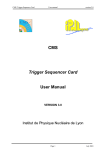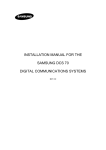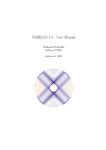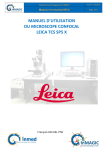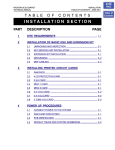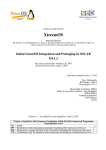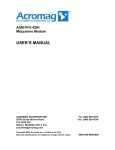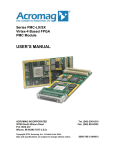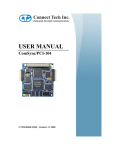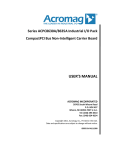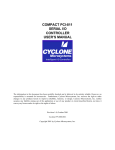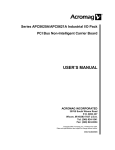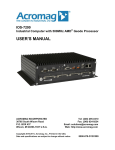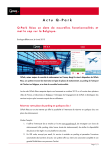Download pdf version - Institut de Physique Nucleaire de Lyon
Transcript
CMS Trigger Sequencer Card User manual version 4.0 CMS Trigger Sequencer Card User Manual VERSION 4.0 Institut de Physique Nucléaire de Lyon Page 1 July 2003 CMS Trigger Sequencer Card User manual version 4.0 1 Contents 1 CONTENTS 2 2 FIGURES 4 3 TABLES 4 4 INTRODUCTION 5 4.1 GENERAL DESCRIPTION 5 4.2 ARCHITECTURE 6 4.3 CAUTION FOR HEATING 6 5 HARDWARE 7 5.1 FRONT PANEL 7 5.2 INSIDE CONNECTORS 8 5.3 PCI 11 5.4 FPGA 11 5.5 EPROMs 11 5.6 DELAY LINES 11 5.7 JUMPERS & SWITCHES 12 5.8 BUTTONS 12 5.9 LEDS 13 5.10 SUPPLIES 13 6 TSC FUNCTIONALITIES 14 6.1 FONCTIONNAL BLOCK DIAGRAM 14 6.2 TRIGGER PART 14 6.2.1 TRIGGER SOURCE 14 6.2.2 TRIGGER FILTER 15 6.2.2.1 INHIBIT 15 6.2.2.2 GATE 15 6.2.2.3 MINIMUM NUMBER OF CLOCKS BETWEEN TRIGGERS 6.2.2.4 COUNTING 17 6.2.2.5 TRIGGER STAMP COUNTER AND FIFO 18 6.2.2.6 RESET TRIGGER FILTER 18 6.3 CLOCKS 18 6.4 SEQUENCER PART 18 6.4.1 TRIGGER SEQUENCE 18 6.4.2 CALIBRATION SEQUENCE 18 6.4.3 RESET SEQUENCE 19 6.4.4 FED CLOCK AND TRIGGER 19 6.5 ENCODER PART 19 6.6 PULSER 20 6.7 FIRMWARE 20 6.8 INTERRUPTS 20 6.9 RESETS 20 6.10 I2C BUSES 20 6.10.1 LOCAL I2C 20 6.10.2 EXTERNAL I2C 20 7 SOFTWARE 22 7.1 PCI CONFIGURATION AND ADDRESS MAP 22 7.1.1 MEMORY REQUIREMENTS 22 7.1.2 PCI CONFIGURATION REGISTERS 22 7.1.3 BRIDGE INITIALIZATION 23 7.2 I/O MAPPING 24 7.2.1 REGISTERS 25 7.3 SOFTWARE INSTALLATION 29 Page 2 17 July 2003 CMS Trigger Sequencer Card User manual 7.4 DRIVER 29 7.5 DEVICE 29 7.6 USER LEVEL ROUTINES 30 8 GETTING STARTED 31 8.1 HARDWARE VERIFICATIONS 31 8.2 SOFTWARE TESTS 31 9 CONTACTS & ORDERING INFORMATION 31 10 VERSION AND HISTORY 31 11 APPENDIX 1 : TPO USER MANUAL 32 11.1 INTRODUCTION 11.2 HYBRID COMPATIBLE LINES (J11 TO J14) 11.3 GENERAL PURPOSE I2C LINES (J32, J18, J47 AND J48) 11.4 FED CLOCK AND TRIGGER ( J3 TO J8) 11.5 OTHER SIGNALS (J15) 11.6 SUPPLYING (J16) 11.7 SCHEMATICS Page 3 version 4.0 32 33 33 35 35 35 36 July 2003 CMS Trigger Sequencer Card User manual version 4.0 2 FIGURES Figure 1 Figure 2 Figure 3 Figure 4 Figure 5 Figure 6 Figure 7 Figure 8 Figure 9 Figure 10 Figure 11 Figure 12 Figure 13 Figure 14 Figure 15 Figure 16 Figure 17 Photograph of TSC Block Diagram Area (grey) to be fanned Front panel connectors Jumpers Fonctionnal block diagram Trigger gate timing Trigger gate cabling Trigger gate calibration TPO Functionnal block diagram I2C output jumper location I2C output supply I2C Cell functionnal diagram for J32 I2C Jumper default configuration TPO Schematics no1 TPO Schematics no2 TPO Top view 3 TABLES Table 1. Description of J8 local supply connector Table 2. Description of JTAG connector Table 3. Description of J1 connector Table 4. Description of J2 connector Table 5 Jumper settings Table 6 LEDs Table 7 Summary of the register address mapping Table 8 Distribution of external I2C channels Table 9 PCI bridge configuration registers Table 10 Local bridge configuration registers Table 11 Summary of the register address mapping Table 12 Different jumper configurations for J32 Table 13 Summary of TPO connections Page 4 July 2003 CMS Trigger Sequencer Card User manual version 4.0 4 INTRODUCTION 4.1 GENERAL DESCRIPTION The TSC (Trigger Sequencer Card) is intended to assume timing aspects in the CMS silicon tracker test stations. It is presented in a PCI form factor for workstations (Figure 1). Placed between trigger, clock source and FEC-CCU, it can also supply a laser pulser. The trigger part assumes gating, counting and blocking following triggers. Internal clock and triggers are also provided. The sequencer part matches all APV requests including trigger, calibration and reset. All the necessary software for TSC set up is provided. Figure 1 Photograph of TSC Page 5 July 2003 CMS Trigger Sequencer Card User manual version 4.0 4.2 ARCHITECTURE Figure 2 Block Diagram Main parts of this card include a PCI bridge to interface PCI bus, a FPGA for trigger logic, allowing future modifications, biphase modulator for TTCrx, 2 DLLs for precise delays and several level adaptors. 4.3 CAUTION FOR HEATING Because of ECL use, this card produces heat. Fanning is mandatory. Figure 3 Area (grey) to be fanned Page 6 July 2003 CMS Trigger Sequencer Card User manual version 4.0 5 HARDWARE 5.1 FRONT PANEL Figure 4. Front panel connectors • LED trigger accepted : highlights each time a trigger is accepted and sent to APVs. • FED clock and trigger (4x): LVDS clock and trigger outputs for FED(s). • Trigger input : NIM input for external trigger. • Pulser out : NIM output to trigger a pulser. • Inhibit trigger : NIM input for hardware inhibit trigger. Previously (<1.5.4) was Reset Trigger Filter : NIM input for hardware Reset Trigger Filter. • Clock input : ECL external 40 Mhz clock input. • Optical output : Optical connection to the optical FEC input. Page 7 July 2003 CMS Trigger Sequencer Card User manual version 4.0 5.2 INSIDE CONNECTORS Local supply J8. For debugging. HE10 14 pins connector Pin number 1 2 3 4 5 6 7 8 9 10 11 12 13 14 Signal name VCC VCC VCC GND GND GND GND GND GND VM12_PCI VM12_PCI VIO DVDD DVDD Description + 5 volts + 5 volts + 5 volts -12 volts -12 volts Universal PCI supply +3.3 volts local from +5 volts +3.3 volts local from +5 volts Table 1. Description of local supply connector JTAG J9. HE10 10 pins connector. Pin number 1 2 3 4 5 6 7 8 9 10 Signal name TCK GND TDO DVDD TMS DVDD Nc Nc TDI GND Description JTAG clock JTAG data out +3.3 volts local from +5 volts JTAG mode select +3.3 volts local from +5 volts JTAG data in Table 2. Description of JTAG connector One of the PCI for workstations form factor's problem is the short front panel size. Because of this, two more SMC 50 pins connectors were added, J1 and J2. See below tables 3 and 4 for description. Page 8 July 2003 CMS Trigger Sequencer Card Pin number 1 2 3 4 5 6 7 8 9 10 11 12 13 14 15 16 17 18 19 20 21 22 23 24 25 26 27 28 29 30 31 32 33 34 35 36 37 38 39 40 41 42 43 44 45 46 47 48 49 50 User manual Signal name HYB7_SDA HYB7_SCL GND HYB6_SDA HYB6_SCL GND HYB5_SDA HYB5_SCL GND HYB4_SDA HYB4_SCL GND HYB3_SDA HYB3_SCL GND HYB2_SDA HYB2_SCL GND HYB1_SDA HYB1_SCL GND HYB0_SDA HYB0_SCL GND RESET_HYB GND GND DVDD DVDD DVDD GND GND TRAPV0_H TRAPV0_L GND GND version 4.0 Description Technology I2C data for hybrid #7 I2C clock for hybrid #7 *** *** I2C data for hybrid #6 I2C clock for hybrid #6 *** *** I2C data for hybrid #5 I2C clock for hybrid #5 *** *** I2C data for hybrid #4 I2C clock for hybrid #4 *** *** I2C data for hybrid #3 I2C clock for hybrid #3 *** *** I2C data for hybrid #2 I2C clock for hybrid #2 *** *** I2C data for hybrid #1 I2C clock for hybrid #1 *** *** I2C data for hybrid #0 I2C clock for hybrid #0 *** *** General hybrid reset *** + 3.3v digital output + 3.3v digital output + 3.3v digital output Clock&Trigger Clock&Trigger LVDS+ LVDS- Table 3. Description of J1 connector *** Open drain maximum 3.3 volts Page 9 July 2003 CMS Trigger Sequencer Card Pin number 1 2 3 4 5 6 7 8 9 10 11 12 13 14 15 16 17 18 19 20 21 22 23 24 25 26 27 28 29 30 31 32 33 34 35 36 37 38 39 40 41 42 43 44 45 46 47 48 49 50 User manual Signal name version 4.0 Description Technology GND SDA0 GND SCL0 GND SDA1 GND SCL1 I2C data for I2C line #0 *** I2C clock for I2C line #0 *** I2C data for I2C line #1 *** I2C clock for I2C line #1 *** APV_trig_h APV_trig _l APV_clock_h APV_clock _l High level APV trigger High level APV trigger High level APV clock High level APV clock LVDS+ LVDSLVDS+ LVDS- Fed_trig_h Fed_trig_l Fed_clk_h Fed_clk_l High level fed trigger Low level fed trigger High level fed clock Low level fed clock LVDS+ LVDSLVDS+ LVDS- Fed_trig_h Fed_trig_l Fed_clk_h Fed_clk_l GND INHIBIT TRIGGER_OUT RES_DLLOUT3 SCLI2C_FPGA SDAI2C_FPGA GND RESNIM GND GND CKAPV_ECLN CKAPV_ECLP GND GND TRAPV_ECLN TRAPV_ECLP GND GND High level fed trigger Low level fed trigger High level fed clock Low level fed clock LVDS+ LVDSLVDS+ LVDS- Trigger inhibit input Trigger accepted output Reserved CMOS output Local I2C clock Local I2C data CMOS In *** *** *** *** Reserved NIM output NIM Out APV clock APV clock ECLECL+ APV trigger APV trigger ECLECL+ 3.3v Table 4. Description of J2 connector *** Open drain maximum 3.3 volts Page 10 July 2003 CMS Trigger Sequencer Card User manual version 4.0 5.3 PCI Bridge Mode Connector Clock Speed Switching regime Bus width PCI Specification PLX 9080-3 J PCI J3 <= 33MHz 5V 32 bit v 2.1 5.4 FPGA ALTERA EP20K60EQC208-1X The FPGA is the heart of the TSC. It assumes all functions of the trigger and sequencer parts, except fine delays. It is reconfigurable in firmware and thereby maintains a flexible hardware architecture. During normal operation the FPGA is loaded on power up from the on-board Flash memory. 5.5 EPROMs • NM93CS46N (M32) : Serial CMOS EEPROM 64 x 16bits. It contains PCI configuration parameters, including the TSC serial number. • EPC2LC20 (M28) : Flash EPROM containing the FPGA design file. 5.6 DELAY LINES Type : CERN 00051BS PHOS4 Rev 1.2 from Microelectronics Group. Description : • ASIC providing 4 calibrated delay lines • Step 1 nS • I2C programmable Page 11 July 2003 CMS Trigger Sequencer Card 5.7 User manual version 4.0 JUMPERS Figure 5. Jumpers The user should not have to keep busy with jumpers. • PLX PCI bridge mode S2 : PLX normal mode : closed. PLX test mode :open. By default set to closed • PLX EPROM S3 : Serial EPROM protected mode : closed , non protected mode : open. By default set to closed • EPROMs programming PLX EPROM Programmation mode Closed Open Open Open Open S4 S5 S6 S7 S8 FPGA flash EPROM programmation mode Open Closed Closed Closed Closed Table 5 : Jumper settings 5.8 BUTTONS 2 pushbuttons S1 and S10 S1 : Pushing this button - asks for a FPGA reset. The FPGA returns to a cold start status. The contents of registers are lost. S10 : For proper use, a PLL is used in the FPGA, pushing this button asks for this PLL reset inside the FPGA. Nothing to see with hybrid PLL. Page 12 July 2003 CMS Trigger Sequencer Card 5.9 User manual version 4.0 LEDS D1 is placed on the front panel, D7,D8 and D9 are placed close to the FPGA. Extingished D1 D7 D8 D9 FPGA is initialized No clock is present lighted Each time a trigger is sent to hybrid FPGA is not initialized Not used Clock OK Table 6 : LEDs 5.10 SUPPLIES Except VIO, only 5 volts is required for this card. 3.3 and 1.7 volts are made locally. There was a modification on 3.3 volts. It is now made on a little mezzanine card pluged in J8. This mezzanine card has 2 functions : - 3.3 volts regulation from 5 volts supply. - Delayed relay to insure short rising edge of 3.3 volts for Delay Lines supply management. Page 13 July 2003 CMS Trigger Sequencer Card User manual version 4.0 6 TSC FUNCTIONALITIES 6.1 FONCTIONNAL BLOCK DIAGRAM Figure 6. 6.2 Fonctionnal block diagram TRIGGER PART 3 ways of triggering exist : - External trigger NIM input. Frequency programmable internal pulse generator. Software triggered pulse. The trigger part is essentialy a trigger filter. Many functions are reset by Reset Trigger Filter. 6.2.1 TRIGGER SOURCE • Selecting internal or external source. By writing bit3=0 and bit2=0 in trigger register control (PCIBAR2+0CH), external trigger is selected By writing bit3=1 and bit2=0 in trigger register control (PCIBAR2+0CH), internal trigger is selected Page 14 July 2003 CMS Trigger Sequencer Card • User manual version 4.0 Selecting internal source frequency The internal trigger frequency is selectable by steps of 20 microseconds. The value of the frequency (period) is written into Internal trigger frequency register (PCIBAR2+10H). • Selecting soft trigger First, select soft trigger source by writing bit3=1 and bit2=1 in trigger register control (PCIBAR2+0CH). Each time a soft trigger is to be sent, write in soft trigger register control (PCIBAR2+34H). 6.2.2 TRIGGER FILTER 6.2.2.1 INHIBIT The trigger can be inhibited by entering a logic level 0 on the inhibit pin (CMOS non 5 volts tolerant pin 34 connector J2). A NIM input (previously Reset Trigger Filter) is now (>=1.5.4) an inhibit trigger input. It can also be inhibited by writing bit1=1 in trigger register control (PCIBAR2+0CH). At power on this function is disabled : bit1=0. 6.2.2.2 • GATE Theory of operation Figure 7. Trigger gate timing A gate signal synchronized with the 40 Mhz clock is made localy, programmable in position and width by steps of 1nS. If the external trigger rising edge happens during the high level of this gate, the trigger is accepted and a signal output trigger (25nS duration) is generated in the following clock period. DLLs are used to make the gate, position and width are 25 levels [0,24] programmable by steps of 1 nS. Set position by writing bit[6:5] = 01 and position value in bit[4:0] of Local I2C DLL1 register (PCIBAR2+40H). Set width by writing bit[6:5] = 11 and width value in bit[4:0] of Local I2C DLL1 register (PCIBAR2+40H). This part of the filter may be inactivated by choosing position=0 and width=24. Page 15 July 2003 CMS Trigger Sequencer Card • User manual version 4.0 Gate implementation. DLL1 (M42) is used : see figure 7 - Line 0 + line 1 for trigger gate position - Line 2 + line 3 for trigger gate width The DLLs have minimum signal delay. For trigger gate position and width, 2 lines are connected in series, one to calibrate (insure 25 nS exactly) and the other to be used as an exact delay. The first is calibrated automatically (see Software chapter), the second is set by the user. Therefore, line 0 and 2 should be calibrated automatically while line 1 should be set for gate position and line 3 set for gate width. All delay lines are set to 0 delay by the FPGA at power on. Figure 8. Trigger gate cabling All software related to the gate management is located in : ~/Daq_Cms_Like/DeviceDriver/Tsc_Driver/gate/ The tar file can be found at the following address : http://lyoinfo.in2p3.fr/cms/cmstraces/tscweb/software/gate.tar Page 16 July 2003 CMS Trigger Sequencer Card User manual version 4.0 Gate calibration Tools are proposed in order to calibrate gate width and position. For this purpose, a test setting was implemented in the FPGA (see figure 8). This mechanism switches 40 Mhz clock on 2 lines : - One connected to a Non Gated Trigger Counter through a synchronisation circuit. - The other is connected to a Gated Trigger Counter through the gate circuit and a synchronisation circuit. Thereby, it becomes easy to check if the gate is transparent or not. This mechanism is triggered by writing in Gate Delay Calibration Request register (PCIBAR2+50H). Scanning Local I2C Status register (PCIBAR2+44H) bit8=1 means calibration is done. The counters are readable in Local I2C Status register (PCIBAR2+44H). The content of Non Gated Trigger Counter is in bit[15:12], the content of Gated Trigger Counter is in bit[19:16] By reading these counters while scanning for different values of gate width and position, it is possible to calibrate the gate. A calibrating function, using these features, is implemented in the constructor of TscDevice class. Figure 9. 6.2.2.3 Trigger gate calibration MINIMUM NUMBER OF CLOCKS BETWEEN TRIGGERS In order not to disturb APV sequence, the number of clocks between triggers must be decided. A counter assumes this. This counter is reset by Reset Trigger Filter. It acts only for external triggers. The minimum is set to 3, it is programmable up to 65535 by writing the value in Minimum number of clocks register (PCIBAR2+4H). 6.2.2.4 COUNTING The last stage of the trigger filter is a counter. It may be used to manage the spill size of the ADC. This counter is fully programmable from 0 to 65535 by writing the value in Trigger maximum count register (PCIBAR2+8H). After initialization and during acquisition, the counter is incremented of 1 each trigger, the current value can be read in Trigger counter current value (PCIBAR2+28H). When the current read value reaches the initial set value, the triggers are blocked and an interrupt is sent. Note that the set value 0 is reserved for no counting, in this case the counter is transparent and there is no need to reset the trigger filter. Page 17 July 2003 CMS Trigger Sequencer Card new 6.2.2.5 User manual version 4.0 TRIGGER STAMP COUNTER AND FIFO A 32 bits counter has been added. This counter runs at 40 MHz. It is reset by the resetFED command. When a trigger occurs, the counter value is loaded in a FIFO. The FIFO is 512 deep. FIFO management • • • FIFO status : Read the Trigger stamp FIFO status register (PCIBAR2+74H) FIFO clear : Write to Clear Trigger stamp FIFO register (PCIBAR2+74H) FIFO read : Read Trigger stamp FIFO content register (PCIBAR2+78H) 6.2.2.6 RESET TRIGGER FILTER When the trigger counter is set to a value different from 0, the triggers are blocked when the counter reaches this set value. Then, to go on, a hardware or software Reset Trigger Filter order has to be given. • Software reset : write into Reset Trigger Filter register (PCIBAR2+2CH). • Hardware reset : NIM pulse in the Reset Trigger Filter input. The hardware reset is active at the high level (-800 mV) of the pulse. Note that the trigger filter is transparent during the high level of the pulse, this is why this reset pulse has to be short. The minimum length is 25 nS. NO MORE AVIALABLE 6.3 CLOCKS The clock source can be choosen between both an ECL external clock input and a 40 Mhz internal clock generator. The choice is done by writing in Trigger register control (PCIBAR2+CH) bit6=1 for external source and bit6=0 for internal source. At power up the internal source is selected. If external source is selected, the input has always to be fed, if it is not the case, the 1 nS delay in the DLLs is no more garanteed. A cold start is then necessary. 6.4 SEQUENCER PART The sequencer has : • 2 inputs : clock and trigger from the trigger filter. • 5 outputs : APV clock and trigger, FED clock and trigger, pulser. The APV trigger output of the sequencer can hold trigger, calibration and reset sequences. Refer to APV user manual for details. 6.4.1 TRIGGER SEQUENCE This is the trigger input of the sequencer delayed of an entire number of clocks called APV latency. The APV latency can be updated by writing the latency value [1, 65535] in the APV latency register (PCIBAR2+18H). 6.4.2 CALIBRATION SEQUENCE The calibration sequence is a 110 sequence, it comes an entire number of clocks after the trigger input of the sequencer. This number is called Calibration latency. The Calibration latency can be updated by writing the latency value [1, 65535] in the Calibration latency register (PCIBAR2+38H). First, the output of this Calibration sequence must be enabled by writing bit4=1 in the trigger register control (PCIBAR2+0CH). Page 18 July 2003 CMS Trigger Sequencer Card User manual version 4.0 6.4.3 RESET SEQUENCE • Reset sequence hardware trigged The reset sequence is a 101 sequence, it comes an entire number of clocks after the trigger input of the sequencer. This number is called Reset latency. The Reset latency can be updated by writing the latency value [1, 65535] in the Reset latency register (PCIBAR2+0). First, the output of this Reset sequence must be enabled by writing bit5=1 in the trigger register control (PCIBAR2+0CH). • Reset sequence software trigged A reset sequence can be asked at any time by writing in the Soft APV reset register (PCIBAR2+28H). Typically, this is for updating slow control values in the APV. 6.4.4 FED CLOCK AND TRIGGER The TSC can drive up to 10 FED clock and trigger, 4 via the front panel and 6 via J2 connector. • FED trigger latency In order to use correctly the FED without header finding, the FED trigger output is to be delayed a certain number (FED latency) of clocks. This is done by writing latency value [1, 65535] in FED trigger latency register (PCIBAR2+14H). Note that a reset sequence 101 (same as the one for APV) is sent each time a soft APV reset is asked. • Fine FED clock delay The FED clock is tunable in fine delay from 0 to 24 by steps of 1 nS. The DLL2 (M43) line 0 is used for this purpose. Set fine FED clock delay by writing bit[6:5] = 00 and delay value [0,24] in bit[4:0] both in I2CDLL2 register (PCIBAR2+4CH). • Fine FED trigger delay The FED trigger is also tunable in fine delay from 0 to 24 by steps of 1 nS. The DLL2 (M43) line 1 is used for this purpose. Set fine FED trigger delay by writing bit[6:5] = 01 and delay value [0,24] in bit[4:0] both in I2CDLL2 register (PCIBAR2+4CH). In order to reset the FED trigger counter, a reset sequence 101 is sent by writing in FED soft reset register (PCIBAR2+68H). In the same time, an APV Soft Trigger Reset is also sent. All delay lines are set to 0 delay by the FPGA at power on. 6.5 ENCODER PART This encoder is intended to receive the APV clock and trigger outputs of the sequencer in order to encode them by a biphase modulation. This modulated signal supplies the optical transmitter connected to the FEC. This part is the same as the TTCvx one, also implemented in ECL technology. This is why heating problems must be solved by a fan. To produce 40, 80 and 160 Mhz, a PLL (M30) is used. Sometimes it has to be resetted, this is done by writing in Reset encoder PLL register (PCIBAR2+30H). Page 19 July 2003 CMS Trigger Sequencer Card 6.6 User manual version 4.0 PULSER The TSC can drive a pulser. This is the trigger input of the sequencer delayed from 0 to 24 by steps of 1 nS. The DLL2 (M43) line 2 is used for this purpose. This is done by writing bit[6:5] = 10 and delay value [0, 24] in bit[4:0] both in I2CDLL2 register (PCIBAR2+4CH). 6.7 FIRMWARE The firmware is the FPGA design file. It is loaded in the flash EPROM. If updates are necessary, the content of the flash EPROM can be updated by the JTAG connector (J8). In future versions it will be updated through PCI bridge. The version number can be read in Firmware version register (PCIBAR2+7CH). Bit[3:0] means subsubversion number , bit[7:4] means subversion number , bit[11:8] means version number. 6.8 INTERRUPTS An interrupt is sent through the PCI bridge each time an end of trigger counter is reached, for this, the interrupts must be enabled by writing bit0=1 in Trigger control register (PCIBAR2+CH). When the interrupt rises, it has to be catched as soon as possible. Just after, it has to be reset by writing in RAZ interrupt register (PCIBAR2+3CH). Anyway, if it is not seen by the interrupt controler, it is reset automatically after 1.6 millisecond. 6.9 RESETS • PCI reset, Reset Button (S1) - asks for a FPGA reset. - The FPGA returns to a cold start status. - The contents of registers are lost. • Power on/off cycle: The PCI bridge loads the configuration parameters from the serial EEPROM M32. It also produces a PCI reset condition, resulting in a reload of FPGA. 6.10 I2C BUSES 2 I2C buses are held by the FPGA : 6.10.1 LOCAL I2C An I2C bus for local needs, controlling DLL1 and DLL2. It can be accessed by registers 40H through 4CH. 6.10.2 EXTERNAL I2C An I2C bus connected to outside by J1 and J2. - 8 lines are connected by J1, they are destinated to hybrids. - 2 lines are connected by J2, they are destinated to general purpose material. It can be accessed by registers 54H through 64H. In both cases, the lines are connected directly to the FPGA. The outputs are 3.3 volts and the inputs are not 5 volts tolerant. Page 20 July 2003 CMS Trigger Sequencer Card User manual version 4.0 Using external I2C - Select mode The external I2C system assumes 1 through 4 byte, write and read functions plus RAL mode (APV I2C). The mode is selectable in External I2C Mode register (PCIBAR2+54H). - Select address and channel There are 10 external I2C channels switchable (see table 8). I2C address is specified in bit[7:1] and I2C channel in bit[11:8] of External I2C Address + Channel register (PCIBAR2+58H). - Writing data Whatever mode is used, data is written in External I2C Data To Send register (PCIBAR2+5CH). The MS byte(s) are filled with zeros. Note that MSB of data is sent first in the I2C frame. - Reading data Whatever mode is used, data is read in External I2C Data Received register (PCIBAR2+60H). Note that MSB of data word is read first in the I2C frame. - Reading status Reading bit0 of External I2C Status register (PCIBAR2+64H) = 0 means busy state (transaction in progress), = 1 means external I2C bus ready. Write sequence 1) Wait for I2C ready, External I2C Status register bit0=1 2) Select mode in External I2C Mode register 3) Write data in External I2C Data To Send register 4) Write address and channel in External I2C Address + Channel register. This last access triggers the write transaction. Read sequence 1) Wait for I2C ready, External I2C Status register bit0=1 2) Read data in External I2C Data Received register. This last access triggers the read transaction. I2C channel number 0 1 2 3 4 5 6 7 8 9 Type SCL SDA SCL SDA SCL SDA SCL SDA SCL SDA SCL SDA SCL SDA SCL SDA SCL SDA SCL SDA Connector J1 J1 J1 J1 J1 J1 J1 J1 J1 J1 J1 J1 J1 J1 J1 J1 J2 J2 J2 J2 Pin number 23 22 20 19 17 16 14 13 11 10 8 7 5 4 2 1 8 6 4 2 Table 8 Distribution of external I2C channels Page 21 July 2003 CMS Trigger Sequencer Card User manual version 4.0 7 SOFTWARE For users who don't want to worry with register accesses and PCI configuration stuff, see directly §7.5 7.1 PCI CONFIGURATION AND ADDRESS MAP 7.1.1 MEMORY REQUIREMENTS PCI configuration space header type 0 The card has the following PCI space requirements : PCI Configuration Space PCI Memory Space 64 bytes 128 bytes PCI I/O Space is not used. PCI Interrupts are used. No Bus Master behavior All register accesses must be long word (32 bits) access, even if one bit, byte or word is necessary. This concerns write and read accesses. 7.1.2 PCI CONFIGURATION REGISTERS See the table 9 for the list of registers called during the PCI configuration at the driver level. Register Name Vendor ID Device ID PCIREV PCI-CFG address 00H 02H 08H PCIBAR0 10H PCIBAR2 18H PCIILR 3CH Value 10DCH CEF0H EPROM defined System defined System defined System defined Comments CERN ID. Value read from serial EPROM Value read from serial EPROM PCI revision ID register. Loaded from the serial EPROM, this value is interpreted as the card serial number Base address register for PCI memory space accesses to PCI9080 bridge local registers Base address register for PCI memory space accesses to TSC registers PCI Interrupt Line register Table 9 PCI bridge configuration registers Vendor ID : CERN number (10DCH) is used. Device ID : CEF0H Vendor ID, device ID, revision ID are taken from EPROM at boot time. Page 22 July 2003 CMS Trigger Sequencer Card User manual version 4.0 7.1.3 BRIDGE INITIALIZATION PCIBAR0 is remapped to an address during device opening, local configuration register offsets are relative to this address. See the table 10 for the list of registers called during the local bridge configuration. Register Name MARBR PCI address offset 08H Value 1200000H INTCSR 68H F010100H Comments Mode arbitration register. Bit21 : Local Bus Direct Slave Give up Bus Mode Bit24 : Delayed Transaction Mode Interrupt control/status register Bit 8 : PCI Interrupt Enable Bit11: PCI Local Interrupt Enable Bit16 : Local Interrupt Output Enable Bit27-24 : ! Target abort Table 10 Local bridge configuration registers Page 23 July 2003 CMS Trigger Sequencer Card User manual version 4.0 7.2 I/O MAPPING Address PCIBAR2 PCIBAR2 + 4H PCIBAR2 + 8H PCIBAR2 + CH PCIBAR2 + 10H PCIBAR2 + 14H PCIBAR2 + 18H PCIBAR2 + 1CH PCIBAR2 + 20H PCIBAR2 + 24H PCIBAR2 + 28H PCIBAR2 + 2CH PCIBAR2 + 30H PCIBAR2 + 34H PCIBAR2 + 38H PCIBAR2 + 3CH PCIBAR2 + 40H PCIBAR2 + 44H PCIBAR2 + 48H PCIBAR2 + 4CH PCIBAR2 + 50H PCIBAR2 + 54H PCIBAR2 + 58H PCIBAR2 + 5CH PCIBAR2 + 60H PCIBAR2 + 64H PCIBAR2 + 68H PCIBAR2 + 6CH PCIBAR2 + 70H PCIBAR2 + 74H PCIBAR2 + 78H PCIBAR2 + 7CH Read function Reset latency Minimum number of clocks Trigger maximum count Trigger register control Internal trigger frequency FED trigger latency APV latency Write function Reset latency [1, 65535] Min number of clocks [3, 65535] Trigger maximum count [1, 65535] Trigger register control Internal trigger frequency FED trigger latency APV latency Trigger counter current value APV soft reset Reset trigger filter Reset encoder PLL Soft trigger Calibration latency RAZ interrupt Local I2C DLL1 (gate) Calibration latency Local I2C DLL1 (gate) Local I2C status Local I2C DLL2 (FED, pulser) External I2C mode + reset External I2C address + channel External I2C data to send External I2C data received External I2C status FED soft reset Hybrid Reset Hybrid Reset Trigger stamp FIFO status Trigger stamp FIFO content Firmware version Table 11 Local I2C controller init Local I2C DLL2 (FED, pulser) Gate delay calibration request External I2C mode + reset External I2C address + channel External I2C data to send Clear Trigger stamp FIFO Summary of the register address mapping All register offsets are in local space 0 and referenced to PCIBAR2. Page 24 July 2003 CMS Trigger Sequencer Card User manual version 4.0 7.2.1 REGISTERS PCIBAR2+0H Bit 15:0 31:16 Reset latency R/W Description Reset latency value [1, 65535] Reserved Write Yes Yes Value after Reset 0 0 Read Yes Yes Write Yes Yes Value after Reset 0 0 PCIBAR2+8H Maximum trigger count Bit Description 15:0 Maximum trigger counter value [0, 65535] 31:16 Reserved R/W Read Yes Yes Write Yes Yes Value after Reset 0 0 PCIBAR2+CH Trigger register control Bit Description 0 Interrupt 1 : Enable 0 : Disable 1 Inhibit 1 : Enable 0 : Disable 3:2 00 No trigger 01 Select external trigger 10 Select internal trigger 11 Select soft trigger 4 Calibration 1 : Enable 0 : Disable 5 Reset 1 : Enable 0 : Disable 6 Clock 1 : External 0 : Internal 7 Gate shortcut 1 : gate pass all 0 : normal gate 8 Reserved 9 Inhibit source 1 : FIFO 0 : normal 10 1 : Use APV emulator 0 : Don’t use 31:11 Reserved R/W Read Yes Yes Yes Write Yes Yes Yes Value after Reset 0 0 00 Yes Yes Yes Yes Yes Yes Yes Yes Yes Yes Yes Yes 0 0 0 0 0 0 Yes Yes 0 PCIBAR2+10H Internal trigger frequency Bit Description 15:0 Number of 10 microseconds periods [1, 65535] 31:16 Reserved R/W Read Yes Yes Write Yes Yes Value after Reset 1 0 PCIBAR2+14H R/W Write Yes Yes Value after Reset 0 0 Write Yes Yes Value after Reset 0 0 Write Yes Value after Reset 0 PCIBAR2+4H Bit 15:0 31:16 Bit 15:0 31:16 Minimum number of clocks Description Minimum number of clocks value [3, 65535] Reserved FED trigger latency Description FED trigger latency value [1, 65535] Reserved PCIBAR2+18H Bit 15:0 31:16 Read Yes Yes R/W Read Yes Yes APV latency R/W Description APV latency value [1, 65535] Reserved Read Yes Yes PCIBAR2+1CH PCIBAR2+20H PCIBAR2+24H PCIBAR2+28H Bit 31:0 APV Soft reset Write only Description Read No APV Soft reset Page 25 July 2003 CMS Trigger Sequencer Card PCIBAR2+28H Bit 15:0 31:16 Bit 31:0 Bit 15:0 31:16 Bit 31:0 31:7 Reset encoder PLL Value after Reset 0 0 Write Yes Value after Reset 0 Write No No Value after Reset DEAD 0 Write Yes Value after Reset 0 Write Yes Value after Reset 0 Write Yes Yes Value after Reset 0 0 Write Yes Value after Reset 0 Read No No Write Yes Yes Value after Reset 0 00 No Yes 0 Read only Read Yes Yes Write only Read No Soft trigger generation Write only Read No Calibration latency R/W Description Calibration latency value [1, 65535] Reserved Read Yes Yes RAZ interrupt Write only Description Read No RAZ interrupt PCIBAR2+40H Bit 4 :0 6 :5 Trigger status register (for debug) Description Output one soft trigger pulse PCIBAR2+3CH Write No No Read No Description Reset encoder PLL PCIBAR2+38H Read only Write only Description Trigger status register (answers DEADH) Reserved PCIBAR2+34H Bit 31:0 Reset trigger filter Description PCIBAR2+30H version 4.0 Read Yes Yes Reset trigger filter PCIBAR2+2CH Bit 15:0 31:16 Trigger counter current value Description Trigger counter current value Reserved PCIBAR2+2CH Bit 31:0 User manual Local I2C DLL1 (gate) R/W Description Delay value [0, 24] Line 0 : 00 position calibration Line 1 : 01 user gate position Line 2 : 10 width calibration Line 3 : 11 user gate width Reserved Proper address of DLL1 chip is hardware coded. The DLL chips are not readable, therefore, this R/W register returns the last write values not necessarily the effective ones that stand in the DLL chip. Page 26 July 2003 CMS Trigger Sequencer Card PCIBAR2+44H Bit 2 :0 3 7 :4 8 11:9 19:12 31:20 Read only Description Reserved 0 : busy 1 : DLL ready for new I2C transaction Reserved 0 : Calibration not done 1 : Calibration done Reserved Gated trigger counter value Reserved Read Yes Yes Yes Yes Yes Yes Yes 31:7 Description Bit 3:0 4 31:4 Write Yes Value after Reset Read No No Write Yes Yes Value after Reset 0 00 No Yes 0 Write Yes Value after Reset 0 Write Yes Value after Reset 0000 Yes Yes 0 0 Read Yes Yes Write Yes Yes Yes Yes Value after Reset 0 0000 0000 0 Write Yes Value after Reset 0 Write only Gate delay calibration request Write only Read No External I2C mode R/W Description Read 0000 Single byte write Yes 0001 Single byte read 0010 Double byte write 0011 Double byte read 0100 Triple byte write 0101 Triple byte read 0110 Quadruple byte write 0111 Quadruple byte read 1001 1 byte write + read (RAL mode) 1 : Reset external I2C controller, has to be released to 0 Yes Reserved Yes External I2C address + channel Description Reserved I2C address I2C channel [0, 9] Reserved PCIBAR2+5CH Bit 31:0 Value after Reset 000 0 0000 0 000 0 0 R/W Description PCIBAR2+58H Bit 0 7:1 11:8 31:12 Local I2C DLL2 Gate delay calibration PCIBAR2+54H Write No No No No No No No Read No Description Delay value [0, 24] Line 0 : 00 FED clock delay Line 1 : 01 FED trigger delay Line 2 : 10 Pulser delay Line 3 : 11 reserved (connector J2 pin 36) Reserved PCIBAR2+50H Bit 31:0 Local I2C controller init (not used) Reserved PCIBAR2+4CH Bit 4 :0 6 :5 version 4.0 Local I2C status PCIBAR2+48H Bit 31:0 User manual R/W (see table 7) External I2C data to send Description R/W Read Yes Data to send Page 27 July 2003 CMS Trigger Sequencer Card PCIBAR2+60H Bit 31:0 new 3:2 4 31:5 Bit 31:0 Description Read Yes External I2C status Write No Value after Reset 0 Read Yes Yes Write No No Value after Reset 0 0 Yes Yes Yes No No No 000 0 0 Write Yes Value after Reset 0 Write Yes Yes Value after Reset Read only FED Soft reset Write only Description Read No FED Soft reset PCIBAR2+6CH Bit 0 31:1 Read only Description 0 : busy 1 : Ready for new I2C transaction 0 : last operation not succeeded 1 : last operation succeeded Reserved for internal use Last acknowledgement bit status Reserved PCIBAR2+68H version 4.0 External I2C data received Data received PCIBAR2+64H Bit 0 1 User manual Hybrid Reset R/W Description RESET_HYB : Pin 25 of connector J1 = Value of Bit 0 Reserved Read Yes Yes 0 PCIBAR2+70H APV emulator counter (for clock number , multiply by 280) This counter is incremented (+280) each accepted trigger, is decremented (-1) each clock. Trigger is stopped if counter > stop*280, is released if counter < release*280 Bit Description Read Write Value after Reset 31:16 Number of triggers for release Yes 0 15 :0 Number of triggers for stop Yes 0 PCIBAR2+74H new Bit 31:0 Description Clear trigger stamp FIFO. Sequential 0->1->0 1 Clear active. 0 FIFO free PCIBAR2+74H new Bit 8:0 11:9 12 13 31:14 Bit 31:0 Trigger stamp FIFO status Description Number of events in the FIFO Reserved 0 : Not empty 1 : Empty 0 : Not full 1 : Full Reserved PCIBAR2+78H new Clear trigger stamp FIFO Write only Read No Write Yes Value after Reset 0 Write No No No No No Value after Reset 0 0 0 0 0 Read Yes Write No Value after Reset 0 Read only Read Yes Yes Yes Yes Write No No No No Value after Reset SubSub vers Numb Sub vers. number Version number 0 Read only Read Yes Yes Yes Yes Yes Trigger stamp FIFO content Description The counter value PCIBAR2+7CH Firmware version Bit Description 3:0 Sub Sub version number 7.4 Sub version number 11:8 Version number 31:12 Reserved Page 28 Read only July 2003 CMS Trigger Sequencer Card 7.3 User manual version 4.0 SOFTWARE INSTALLATION Driver and all related software are disponible under CVS. Contact [email protected] 7.4 DRIVER The TSC is delivered with a Linux driver. Minimum version : These files must exist in ~Daq_Cms_Like/DeviceDriverTsc_Driver/ • tscdrv.c driver source code • tcdrv.h header for driver code • Makefile makefile for tscdrv.o target In ~Daq_Cms_Like/DeviceDriverTsc_Driver/ Make the module >make tscdrv.o Install tscdrv.o module (root privilege) >insmod tscdrv.o Verify the module is now present in the module list >lsmod Major number is 147 Steps in the driver : • System initialization • • Scan the PCI bus until the TSC Vendor and Device ID are found Put addresses, interrupt line in tscpmc9080 structure • Device openning • Application calls • • 7.5 Remap PCIBAR0 and PCIBAR2 in Local0 and Local2 of tscpmc9080 structure All useful calls are ioctl specifying the keyword DEVICES 3 kinds of device must exist to access driver: • tscdrv • tscusr • tsci2c Minor 0 and 1. Full control of registers Minor 16 to 32. Used to control throttle and reset trigger filter. Only control of trigger register. 10 devices (0 to 9) to control I2C channels from J1 and J2 In ~Daq_Cms_Like/DeviceDriverTsc_Driver/, prepare devices (root privilege) >make devices The following devices are now installed : Device name /tscdrv00 /tscdrv01 /tscusr00 /tscusr01 /tscusr02 /tscusr03 /tscusr04 /tscusr05 /tsci2c00 Minor number 0 1 16 17 18 19 20 21 32 Device name /tsci2c01 /tsci2c02 /tsci2c03 /tsci2c04 /tsci2c05 /tsci2c06 /tsci2c07 /tsci2c08 /tsci2c09 Page 29 Minor number 33 34 35 36 37 38 39 40 41 July 2003 CMS Trigger Sequencer Card User manual version 4.0 Verify these devices are present in /dev 7.6 • USER LEVEL APPLICATIONS C++ classes in the CMS DAQ software Refer to Daq distribution LxTsc9080 : Access to the registers by read and write methods, to base 0, 2 and 3. Byte, short and long accesses are implemented. TscDevice : A collection of methods similar to TscDescription. • Graphical application TscDialog : a graphical user interface, developped with qt, to control the main parts of the TSC. In ~Daq_Cms_Like/Gui/ - >TscDialog In the first thumb index, open the device. In the second, Set : • Minimum Number of Clocks to 3 • Trigger count to 0 (free run) • Internal trigger frequency to 40 • Trigger control to 8 (Internal source) The Trigger accepted LED on the front panel should blink. 1. 2. 3. 4. 5. 6. 7. 8. In TscDialog, Set APV latency Run PllDialog and request hard reset , init PLL The APV frame should now appear In TscDialog, Set Trigger control to 40 and set Reset latency The APV frame should now be stable In TscDialog, Set Trigger control to 56 and set Calibration latency Run Apv25Dialog and set APV latency according to the previous setting The calibration pulses should appear on the APV frame • Software for gate use All software for gate use, particularily gate calibration can be found in : ~Daq_Cms_Like/DeviceDriverTsc_Driver/gate/ The last tar file can be found at the following address : http://lyoinfo.in2p3.fr/cms/cmstraces/tscweb/software/gate.tar Page 30 July 2003 CMS Trigger Sequencer Card User manual version 4.0 GETTING STARTED 8.1 HARDWARE VERIFICATIONS Fanning : This card has to be fanned. Several solutions exist, the best seems to be a fan fixed to the cover of the PC, airflow crossing the cover by a hole. The fan can be supplied by +5 or +12volts from the PC bus supply . Jumpers S2, S3 and S4 are closed. Others are left open. Power off, install the card in a PCI slot. Turn power on, the LED D9 should light immediately. 8.2 SOFTWARE TESTS After power up, the TSC should be visible by the OS. 2 ways to verify the card was installed correctly : >lspci -vv or >cat /proc/bus/pci/devices. In both cases,the Vendor (10DC) and Device (CEF0) IDs should be mentionned. Install the driver, see §7.4 Install devices, see §7.5 Run application program, see §7.6 9 CONTACTS & ORDERING INFORMATION TSC ordering requests must be addressed to : Didier Contardo email : [email protected] All other questions about TSC can be addressed to : Michel Ageron email : m.ageron@ ipnl.in2p3.fr 10 VERSION AND HISTORY December 2001 : Firmware version 1.4.1. First delivery of the TSC. All functions described in this documentation are implemented except I2C functions. February 2002 : Firmware version 1.5.0. Clock management improved. External I2C implemented except channel 8 and 9 (from J2). June 2002 : Firmware version 1.5.2. Complete implementation of 10 I2C channels. Add trigger stamp counter and FIFO. Use NIM reserved pin as FIFO full. Output separated ECL APV clock and trigger. July 2003 : Firmware version 1.5.3. Improvement of the external I2C controller robustness. Add an external I2C controller reset. Change external I2C controller speed to 100 khz. Changes in hardware Reset Trigger Filter (Synchronism). February 2004 : Firmware version 1.5.4. The previous version gate and external trigger part was not stable. The 1.5.4 version retreives good features. Change hardware Reset Trigger Filter to Inhibit trigger. Change internal trigger base period from 26 uS to 10 uS. Add a bit in trigger control which closes the gate. July 2004 : Firmware version 2.1.0. This version proposes an APV emulator (25.10.04 not yet tested) Page 31 July 2003 CMS Trigger Sequencer Card User manual version 4.0 11 APPENDIX 1 : TPO USER MANUAL 11.1 INTRODUCTION : Because of less connectivity of the PCI for factor, some signals such as Clock&Trigger and I2C do not appear on the back side of the TSC card. These signals are accessible through J1 and J2 connectors. The TPO (Tracker Parallel Output) is supposed to dispatch the signals from J1 and J2 connectors to 4 hybrid compatible lines, 4 general purpose I2C lines, 6 FED Clock and Trigger and other signals. The TPO is a 114x114 mm standalone card that houses : - 4 hybrid compatible lines, including clock&trigger on the same line, I2C for APVs, PLL, Mux and optohybrid. - 4 general purpose I2C lines. - 6 FED Clock and Trigger - Other signals such as Inhibit trigger, Trigger out, NIM FIFO full, APV clock and APV trigger. Figure 10 TPO Functionnal block diagram Page 32 July 2003 CMS Trigger Sequencer Card User manual version 4.0 11.2 HYBRID COMPATIBLE LINES (J11 TO J14) Hybrids require an I2C, a Clock&trigger and a reset lines. - I2C line : through a 3.3v to 2.5v adaptors. Refer to table 12 and figure 10 for plug number or device to open. - Clock&trigger line : the LVDS signal is direcly connected to TSC. - Reset line : a unique reset from the TSC is level adapted and distributed to hybrids. TSC I2C channel number 0 1 2 3 4 5 6 7 8 9 TPO Pin number on TSC 23 22 20 19 17 16 14 13 11 10 8 7 5 4 2 1 8 SDA Connector on TSC J1 J1 J1 J1 J1 J1 J1 J1 J1 J1 J1 J1 J1 J1 J1 J1 J2 J2 SCL SDA J2 J2 4 2 Type SCL SDA SCL SDA SCL SDA SCL SDA SCL SDA SCL SDA SCL SDA SCL SDA SCL 6 I2C channel assignment Plug number Device to open /dev/… Hybrid #1 J14 /tsci2c00 Hybrid #2 J13 /tsci2c01 Hybrid #3 J12 /tsci2c02 Hybrid #4 J11 /tsci2c03 Not routed /tsci2c04 Not routed /tsci2c05 I2C line J47 /tsci2c06 I2C line J48 /tsci2c07 I2C line J18 /tsci2c08 I2C line J32 /tsci2c09 Table 12 Summary of TPO connections 11.3 GENERAL PURPOSE I2C LINES (J32, J18, J47 AND J48) - Jumper location Figure 11 I2C output jumper location Page 33 July 2003 CMS Trigger Sequencer Card User manual version 4.0 - Internal / External supply Figure 12 I2C output supply Limits for external supply : 3.3 volts to 5.5 volts. Note that only the + line is floating, the ground is not. - Using 82B715 The 82B715 is an I2C bus extender allowing long cables, refer to figure 13 for cell J32, the J18, J47 and J48 cells are identical. It is mounted on a support and therefore, can be unused. Refer to table 13 for different jumper combinations. Figure 13 I2C Cell functionnal diagram for J32 J20 J17 J23 J30 J26 J28 with 87B715 with pull up without pull up X X X X without 87B715 with pull up without pull up X X X X X X X X Table 13 Different jumper configurations for J32 Page 34 July 2003 CMS Trigger Sequencer Card User manual version 4.0 - Default configuration Figure 14 I2C Jumper default configuration - Internal supply - Use 87B715 - All pull up resistance swiched 11.4 FED CLOCK AND TRIGGER ( J3 TO J8) On the front pannel, there are 4 FED clock and trigger lines. 6 others on J2, they are routed on TPO. Add some more Lemo plugs to use these lines. 11.5 OTHER SIGNALS (J15) Some other signals on J15 - Inhibit trigger - FIFO full - APV clock - APV trigger 11.6 a CMOS input (non 5 volts tolerent) pulled up to 3.3 volts, when shorted at 0 volts, any trigger output is inhibited a NIM signal indicating event counter FIFO is full the only outputs where APV clock and trigger are separated SUPPLYING (J16) This card must be supplied with 5 volts. J16 Pin 1 -> +5 volts Pin 2 -> GND An on board regulator supplies 2.5 volts for hybrid interface. Page 35 July 2003 CMS Trigger Sequencer Card 11.7 User manual version 4.0 SCHEMATICS Figure 15. TPO Schematics no1 Page 36 July 2003 CMS Trigger Sequencer Card User manual Figure 16. version 4.0 TPO Schematics no2 Page 37 July 2003 CMS Trigger Sequencer Card User manual Figure 17. version 4.0 TPO Top view Page 38 July 2003






































